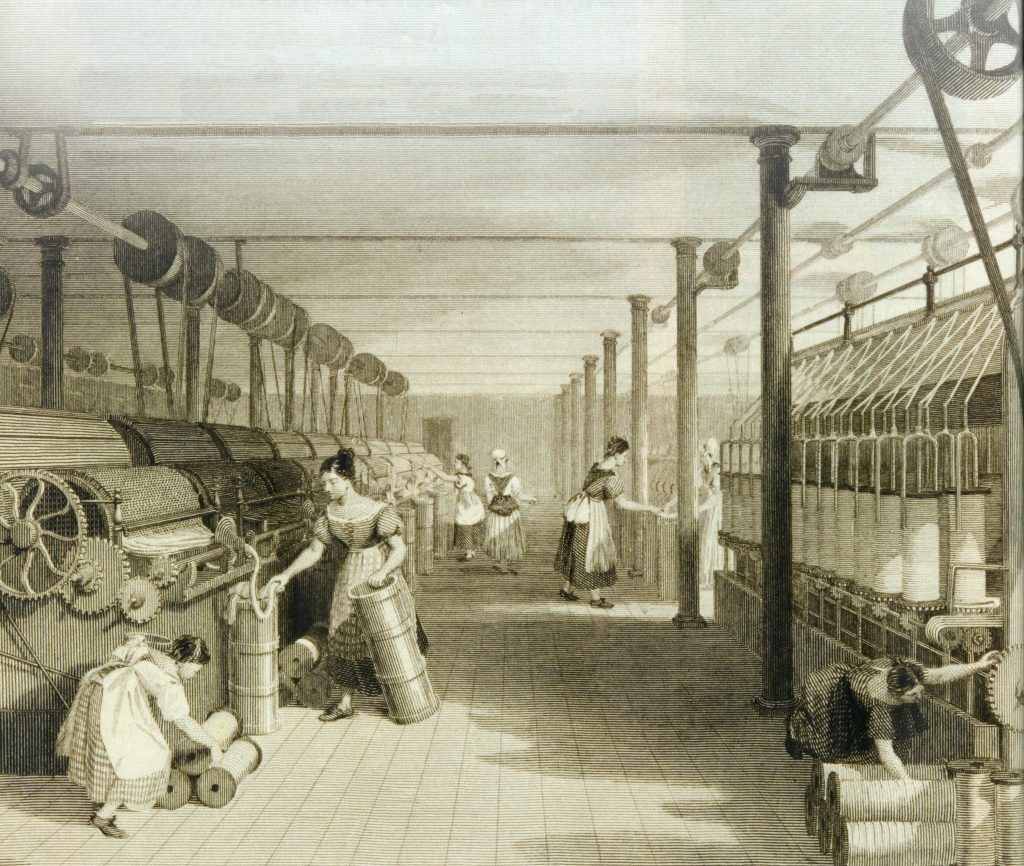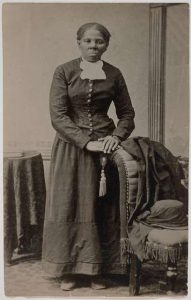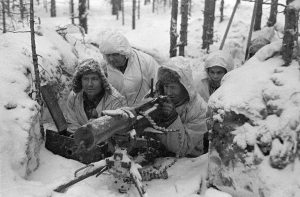Children today spend five days a week going to school for eight hours. During the first half of the nineteenth century in Britain, this was not the case. Instead, children even as young as five or six would toil all day long in factories or in mines. They had no breaks, no time off, and no schooling. Their work often led to horrible accidents, children being injured for life, and children left without an education.
Children laboring, of course, did not start with the British Industrial Revolution. It had been a normal part of life in Europe since the middle ages, when children helped their parents on farms and with household work. The people’s perception of this work, however, changed during the Industrial Revolution, since that is when people began to see this new kind of labor, factory labor, as an injustice and even criminal.1
The Industrial Revolution began in Britain during the 1780’s and rapidly changed the work process and the social relations of work. Prior to the Industrial Revolution, most people worked directly in the production of food, usually as farmers on their own farms. When textile factories began forming in the new factory cities, instead of working on their farms and making what their family needed, people left their farms and moved into the factory cities to make a living. Factory conditions of work, however, were far different from the work rhythms of farm life. In fact, they were brutal in comparison. Factory workers would typically put in between 12 and 16 hour days, working for meager wages. The machines they attended were dangerous, and the workers were often on their feet throughout the day, with perhaps a half-hour break for meals. Among these workers were children, many of whom were as young as five or six years old. Children were valued as workers for their small stature and ability to climb into small places and do things that adults often could not do. This often resulted in mutilation and the loss of appendages for many of these children.2
Children were also valued as workers by the factory owners because of the low wages that they were paid. Men were paid the most in factories, followed by women and then children. These wages, however small, were needed by the families of these children simply to survive. The parents often sent their children out to work to help pay for rent, food, and otherwise help make ends meet.3
One reason that the British public became outraged by child labor practices was the fact that children in factories were not receiving an education. Horace Mann, an American educational reformer, stated:
No greater calamity can befall us as a nation than that our children should grow up without knowledge and cultivation. If we do not prepare them to become good citizens, develop their capacities, enrich their minds with knowledge, imbue their hearts with a love of truth and all things holy, then our republic must go down to destruction as others have gone before it.4
This represents the thoughts of the British at the time, which was being echoed in the United States during its own industrial revolution. People wanted to ensure the future of their nation, which starts with the young. They believed that children should attend school for at least a while.5 This led to several laws being passed to raise the legal age of work.
In 1833, the British Parliament passed the Regulation of Child Labor law to help improve the working conditions for children in factories. The Law limited the age of workers, saying that they had to be older than nine with an age certificate to prove it, and that children 9-13 could not work for more than nine hours a day. Additionally, children 13-18 were not permitted to work longer than twelve hours a day. Along with these work-hour restrictions, the law also made school attendance a two-hour requirement, and said that children could not work at night. Fines for breaking these rules were small, however, so they were frequently violated, often with impunity.6

Many other pieces of legislation were also passed to place limits on the gender, hours, and ages of workers. The Mining Act of 1842 prevented women and girls from working in mines, and the Ten Hours Bill of 1847 set ten as the maximum number of daily working hours for women and children. This act was hated by factory owners because they believed it would hurt the textile industry’s competitiveness worldwide. After these bills, others followed to ensure their effectiveness, and to ensure that they would be properly implemented.7
By 1900, the minimum working age had been raised to twelve years of age and child labor had decreased drastically in Great Britain. However, the introduction of legislation against child labor provoked its share of protests as well. Because of these protests, Parliament established commissions to collect evidence of abusive practices. These were called the Blue Books or Sadler Reports. They interviewed children, parents, factory workers, owners, and even doctors on the condition of children in textile factories. Unsurprisingly, the reports uncovered a range of serious abuses by factory owners and overseers. Unfortunately, most critics just said that the claims were exaggerated in order to continue their money making practices.8
The legislation surrounding the British Industrial Revolution had become very effective by 1900, and child labor and its accompanying abuses had decreased dramatically. By 1900, most children were attending school instead of working in factories. The laws passed finally added up to changing British child labor to being closer to what we see today, a mostly child-free labor system, with children going to school and adults having regulated working hours.
- World History Encyclopedia, 2011, s.v. “Child Labor and Child Labor Laws in Early Industrial Great Britain.” ↵
- James D. Schmidt, “Broken Promises: Child Labor and Industrial Violence,” Insights on Law & Society, no. 3 (Spring 2010): 14–17. ↵
- Robert Whaples, “Hard at Work in Factories and Mines: The Economics of Child Labor during the British Industrial Revolution,” Business History Review, no. 2 (2001): 429. ↵
- Friends’ Intelligencer vol. 28 no. 1 (1871): 336. ↵
- James D. Schmidt, “Broken Promises: Child Labor and Industrial Violence,” Insights on Law & Society, no. 3 (Spring 2010), 14–17. ↵
- Great Britain, “Factories Regulation Act” (1833). ↵
- Steven Toms and Alice Shepherd, “Creative Accounting in the British Industrial Revolution: Cotton Manufacturers and the ‘Ten Hours’ Movement,” MPRA Paper, No. 51478 (2013), 6-8. ↵
- World History Encyclopedia, 2011, s.v. “Child Labor and Child Labor Laws in Early Industrial Great Britain.” ↵



141 comments
Donte Joseph
I think child labor is evil and I am glad that there are now regulations against it. The fact that some kids had to give up their childhoods for a few dollars is wrong and I am surprised that people were okay with that. My only hope is that we as people do not go back to those oppressive times and only move forward.
Lorenzo Rivera
I completely hate child labor because at the end of the day children our the successors of the current generation. Without kids having an actual education, the future of the world is jeopardized because of the greedy individuals in control of child labor. I am glad that today the world is fighting against child labor and have seen the importance of making sure the future generations are well educated. without well educated children, our efforts to change the world are meaningless.
Valeria Perez
Passing all these laws and regulations against child labor are useless if the governments in place don’t enforce them or have a punishment for those who violate the act.
I think that it’s not only the intention that counts but seeing the idea through. Even though these act did improve children’s conditions I can’t imagine a nine-year-old working nine hours in a factory. This is impossible for me to believe but I bet somewhere in the world there are still many children who are under similar conditions.
Taylor Rech
In one of my other classes, we are currently talking about the terrible working conditions and low wages that came to light in the past two decades in various countries that are all competing to have the lowest cost of production in their industry so that they can maximize profits. It is sad to see that this is not a new trend and that these practices are still a problem today just as they were before; however, it is reassuring to read that there have been legislative solutions put into place, and I hope that in the future these solutions spread across the world so that things continue to get better for laborers everywhere.
Indhira Mata
I am glad and relief that the government realized the importance of children’s true purpose at their young age. Kids were meant to go to school in order to learn and become creative thinkers, if they would have been stuck in factories all day working their minds would have only melted and be worn out. Because this article rose a good point, that the future of our nation starts with the youngest minds, because they are the future. So now I am more grateful in remembering that I could have been working 12 hours a day if it was not for those laws passed before our generation.
Brianna Ford
I do not like doing dishes, and I could only imagine what this children would go through. I just don’t understand why families would send their young ones to work such hard and dangerous jobs. It’s sad to know some kids have died on the job because they do not know how to work the machine properly or they were just to little to work the machine. I am glad that kind of government is no more and now kids are all required to go to school and get an education. Times are so different, but I am glad it is.
Sebastian Carnero
Reading this article was a great reminder that gaining wealth is important, but not by any means. Any boss must remember to treat his employees decently. Ignoring this idea is what made families send their children to work and thus creating more than 58 years of child abuse. It is still present today after all that has happened, that is why we must keep analyzing history. In order to know what we must not repeat.
Anna Guaderrama
Okay, although I hate that this happened, there’s a reason why we have laws in place today regarding child labor. Although it can be beneficial to both kids and society, there’s definitely restrictions that should be in place otherwise deaths and injuries can happen. It’s at least a good thing that we learned something from such events. Overall, I enjoyed reading this article and loved how presented the time period and problem.
Miguel Camarillo-Cohen
Good article on child labor. The hardships children lived in the during 1780’s and the 1800. Young children, as little as five to six years old, worked long hours with harsh conditions that led to loss of life, limbs and education was nonexistence. In the 1900’s while better than in the 1800’s labor laws for children do not compare to modern time. Children had no childhood. They worked. The survival of the family, necessitated families accept that their children, very young, six-year-old, to work. Society and families understand anything else. Today, children must attend schools and labor laws are crafted and passed to protect the them.
Maria Mancha
As dangerous as working in factories is, I couldn’t imagine doing that as a child. Especially as young as 5 years old. I never really thought about child labor being before the industrial period, I mean I guess I sort of knew. However you don’t really think about it. I learned new things especially about some of the labor acts, that I knew existed but never really went into depth about them. Therefore I learned a lot from this article and it was very interesting as well as factual